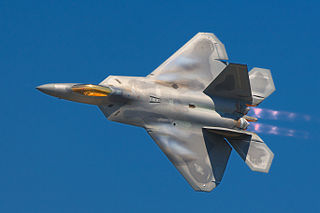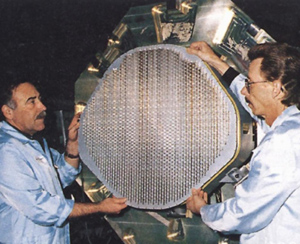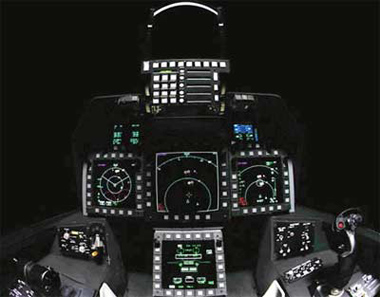The F-22 Raptor was developed by Lockheed Martin in partnership with Boeing. Though initially developed to serve as an air superiority fighter, which meant that it would take control of enemy airspace and destroy any opposition, it has developed into more of a multi-role vehicle. The F-22 is an overwhelming vehicle with capabilities that enable it to perform air-to-air and air-to-ground missions. This meant that it is not only an aerial fighter, but it could also protect and serve troops on the ground. The unique blend of speed, agility, awareness, and precision is what gives this aircraft its dominance, but what truly separates it from the pack is its stealth, otherwise known as low observables. There have been many aircraft that demonstrate stealth, but none do it as well as the F-22, while simultaneously keeping fighter agility at its core. This incredible blend is achieved through three fundamental techniques: shape, material, and surface finishing.
Introduction
Since World War I, aircraft have played a large role in warfare. These incredible engineering marvels have dominated the skies for nearly 100 years and in this relatively short amount of time, have evolved to a point that could not have possibly been imagined by the pioneers of early aircraft design. From linen covered wood frames held together by wires to current vehicles with advanced composite and metal structures, these beasts of the sky have become the pivotal components of any successful military operation. Aircraft are used in modern warfare for transport of vehicles and supplies, reconnaissance, air support, and aerial combat. Nothing demonstrates these qualities better than the F-22 Raptor of the United States Air Force.
The F-22 Raptor was developed by Lockheed Martin in partnership with The Boeing Company (see Fig. 1). Developed as a next-generation fighter for the US Air Force, this aircraft features unparalleled maneuverability and speed. The initial purpose of this vehicle was to serve as an air superiority fighter, which meant that it would take control of enemy airspace and destroy any opposition. However, it has developed into more of a multi-role vehicle. The F-22 is a vehicle with capabilities that enable it to perform air-to-air and air-to-ground missions. This means that it is not only an aerial fighter, but can also protect and serve the troops on the ground. The unique blend of speed, agility, awareness, and precision is what gives this aircraft its dominance, but what truly separates it from the pack is its stealth, otherwise known as low observables [1]. There have been many aircraft that demonstrate stealth, but few have the same aerial agility that this aircraft displays.
How Are Aircraft Detected?
Before getting into the characteristics of the F-22 that allow it to be stealthy, it is important to first see what contributes to observables in an aircraft. Some of the contributors to an aircraft’s signature are visual, acoustic, heat, and infrared, but the main cause of observables in aircraft is radar detection (see Fig. 2). Radar is a detection system that uses high frequency radio waves to determine the location, speed, and size of aircraft [2]. This is achieved by measuring the time that it takes for these waves to bounce off of the aircraft and return to the receiver on the radar device. This information is then sent to a screen, where a team can figure out if an aircraft is approaching their location. In order to limit the radar visibility, an aircraft can lower its observable cross section by deflecting or absorbing these waves. The F-22 is able to limit its observable cross section through three fundamental techniques: shape, material, and surface finishing.
The shape of the F-22 is the most important part of the design. With the correct shape, the majority of the stealth characteristics are already taken care of. The first noticeable aspect of the F-22 design is that it contains an alignment of all hard edges at a swept back angle. Hard edges on an aircraft consist of the wings, tail, inlet lips, and nozzle edges shows how these edges are swept backwards and kept parallel. The hard edges are crucial in stealthy aircraft design because they are the parts that pose the biggest threat for bouncing radio waves back perpendicular to a surface of the aircraft, and therefore back to the receiver. This shape helps scatter the radar waves at an angle away from the receiver. Since all of the edges are angled at the same incidence, it allows for spikes in detection that are concentrated and narrow, effectively lowering the observable cross section [2].
However, the rest of the body can still reflect radio waves. To limit its detection, the entirety of the body is designed using the technique of continuous curves [3]. This means that the F-22 has a constantly curving body that changes its radius of curvature at multiple points. This allows radio waves to scatter in every direction so that no waves are passed straight back to the receiver.
One other part of the aircraft that contributes heavily to its signature is the breaks in the skin. These breaks include access panels, landing gear doors, weapons bays, etc. In most aircraft, these breaks contribute to a significant portion of the observables. To get around this, the F-22 uses “saw-toothed edges.” The breaks in the skin contain these jagged cutouts to help disperse radar waves. Much like the angles in the alignment of the hard surfaces, these saw-toothed edges create a scattering of the waves as to limit the signature.
Materials
While the shape does allow for the majority of stealth characteristics, there are certain places that cannot simply be shaped to deflect radar. In particular, these locations occur where there are seams or breaks. Even though the saw-toothed edges limit the amount of radar bouncing off of the seams, it does not provide enough stealth to pass the rigorous thresholds for the F-22. So, in order to reduce even further the radar signature of the aircraft, specialized radar-absorbing material (RAM) is used. While specifics on RAM are kept classified, the effects can be easily observed.
To understand how RAM works, it is important to remember that radar is composed of radio waves, which are essentially waves of energy. Therefore, designers of RAM noted that by transferring the wave energy to some other form of energy, the wave could be eliminated and provide little radar signature. RAM is applied to the outside of the aircraft and converts the incoming radio waves into magnetic fields and thermal energy [3]. One way to do this is by deflecting the incoming radar beam multiple times within the radar-absorbing coating using a combination of carbon or iron particles. Every time the wave deflects, it loses some of its energy. So the more times it deflects, the weaker the outgoing beam will be.
These materials are essential for a stealth aircraft, but what truly makes the F-22 a superior vehicle is that the designers limited the amount of RAM. This is because RAM, while beneficial to stealth, is heavy. Extensive use of RAM has tremendous impacts on the overall weight of the vehicle, which lowers the efficiency and agility. The F-22 uses these materials at the specific locations where shape cannot solely eliminate observables: the breaks in the skin [4]. The breaks are necessary for the aircraft, so they cannot be eliminated, but by lining them with these materials, the radar signature is lowered.
Conductive Surfaces
Thus far, the purpose for the shape and materials has been to disperse radar waves so that the vehicle cannot be detected. The use of smooth curves and jagged edges has been used to eliminate observables, but the most observable components on an aircraft are the ones that cannot be seen: the internal components. In order to keep the aircraft stealthy, all of the internal components must be invisible to radar. The easiest way to achieve this is through metallic paint that reflects radar waves so that they cannot penetrate beyond the skin [5].
Oddly enough, the most observable part of the aircraft under the skin is not even part of the aircraft. The pivotal part of creating a stealth aircraft is hiding the pilot. The cockpit contributes significantly to the signature of an aircraft and the task of creating low observables with a clear cockpit is a difficult task (see Fig. 3). Most aircraft, like the F-117, achieve this by limiting the pilot’s field of view, using the logic that with a smaller opening, less radar can penetrate. However, this is not true for the F-22. With a full 360-degree field of view, the F-22 sports one of the most advanced stealth canopies in the world. The designers of the F-22 cockpit thought that if the pilot and the cockpit internals caused too much of a signature, then maybe they should just reflect the radar off the surface of the canopy so that it never penetrates in the first place. A metallic coating is applied to the canopy so that radar waves can be reflected away from the aircraft, but the pilot is still capable of seeing out of it [5]. Since the canopy has a continuously curved shape, the amount of radar transmitted back to the receiver is small.
Conclusion
Stealth technology in aircraft has proven to be a crucial part of aerial superiority. New discoveries are constantly being made and companies are working hard to come up with the latest and greatest innovation in stealth fighter technology. Lockheed Martin is already in production of their newest generation fighter, the F-35 Lightning, a vehicle with stealth fighter characteristics, with the added bonus of vertical take-off and landing. Even with this new fighter design, some question whether it can truly stack up to its predecessor. The F-22 dominates the skies, providing astonishing ranges and unprecedented lethality, all wrapped up in an invisible package.






